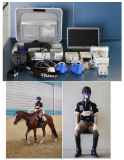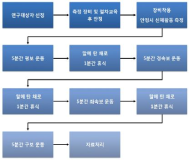Purpose The valuable impacts of exercise-intervention in diverse type of cancer patients were rationally well-prescribed, though many experimental and review researches already performed in this fields. Generally, cancer-related fatigue and pain remains one of the most prevalent problems for cancer populations. Therefore, exercise has become increasingly significant in cancer prevention and progression. The purpose of this recent study was to analyze the combined exercise program on cancer-related fatigue, pain, quality of life and cancer prognosis in diverse type of cancer patients. This study analyses the safety and feasibility of exercise intervention in diverse stages of cancer patients such as early stage, advanced stage and even metastatic periods in cancer populations. we also wanted to know the impacts of dose-response trial of aerobic and resistance exercise on quality of life in cancer survivors. Methods we conducted a comprehensive PubMed/MEDILINE electronic database from Jan 2015 to August 2020. The reference lists of eligible experimental research articles and relevant systemic review articles were checked. Inclusion criteria were adult cancer survivors from randomized controlled trials performing well-tailored exercise intervention programs to diverse type of cancer patients, Using predefined search items ‘exercise-intervention, cancer & immunology’. Based on reference search, more than 100 articles were identified whereas 30 research papers met the inclusion criteria and were well connected with exercise-intervention and cancer progression. we analyzed the connections between physical exercise and cancer intervention in the main text. Results Moderate to vigorous exercise (aerobic and resistance exercise) revealed to decreased level of cancer-related fatigue, pain, and cancer-related symptoms, however increased level of sleep quality, activities of daily living, exercise performance and health- related quality of life. Exercise intervention reduced pro-inflammatory markers and oxidative stress as well as insomnia, fatigue, pain symptoms whereas it enhanced the antioxidant systems and immune functions. In addition, home-based aerobic physical exercise might enhance muscular strength and quality of life in many types of cancer survivors. Psychological intervention also effective for reducing cancer-related fatigue and pain during and after cancer treatment. they might be the much better intervention than available pharmaceutical options. we believe that it is the related mechanisms of immune cell mobilization and activation such as NK cells which is induced by the activation of sympathetic system during and after physical exercise. Conclusion According to the aforementioned results, it was concluded that implementation of exercise intervention appear to be the best non-pharmaceutical interventions for cancer populations, and also revealed to be safe and feasible in early and advanced stages, although not in the metastatic periods. Sometimes, psychological intervention such as mindfulness-based stress reduction (MBSR) might be useful in reducing anxiety, depression, fatigue, pain and enhancing quality of life, quality of sleep for cancer populations. we can conclude, exercise-intervention might not just be prevention effect but might be therapeutics, however more studies are urgently needed to confirm the exercise intervention on the NK-receptors activation and immune connection of cancer populations.
PURPOSE This study analyzed differences in ball speed and kinematic, kinetic characteristics according to stride length. METHODS Forty participants recruited for the study were divided into two groups based on stride length: an over stride group (overstride, OS) and an under stride group (understride, US). Independent sample t-tests were conducted to analyze differences in pelvis and trunk kinematics, ground reaction forces (GRF), and timing of pitch between groups. RESULTS Significant differences were found between groups in drive leg GRF impulse, pelvis, trunk closed angle and pelvic angular velocity (p<.05). Furthermore, the OS had statistically later pitching timings than the US at stride foot contact, maximal external rotation, and ball release phases (p<.05). CONCLUSIONS The maximized drive leg GRF impulse created a wider stride, significantly increasing the pelvis and trunk’s opening angles. Additionally, the OS displayed characteristics of later pitching timings compared to the US. However, since no significant differences in ball speed were observed between groups based on stride length, perhaps stride length does not contribute directly to ball speed. Future research should investigate optimal stride length tailored to individual flexibility and physical characteristics.
PURPOSE This study aimed to analyze the differences in ground reaction forces (GRF) and pelvis and trunk kinematic patterns between groups based on ball speed during pitching. METHODS Twenty-nine males were recruited for this study. Participants were categorized based on ball speed into high (HG), medium (MG), and low (LG) ball speed groups. Statistical analysis was performed using one-dimensional statistical parametric mapping (SPM1D) one-way analysis of variance to compare GRF and pelvis and trunk kinematic patterns, followed by Bonferroni post-hoc tests. RESULTS Drive leg anterior and resultant GRF were greater in the HG than in the LG (p<0.001). The posterior GRF of the stride leg in the HG was greater than in the LG (p<0.008). Additionally, the vertical GRF of the stride leg was greater in the HG than in the LG (p<0.003), as was the resultant GRF of the stride leg (p<0.003). CONCLUSIONS The GRF of the drive and stride legs was significantly related to ball speed, indicating that a pitching strategy to maximize the GRF of the drive and stride legs is required.
PURPOSE This study aimed to understand the changes in the exercise behavior of participants in the exercise-psychological counseling program. METHODS This study sampled adult female participants of C diet camp in Seoul, who were in stages 2~3 of the “Stages of Change Model.” A total of 60 participants were randomly assigned to the counseling group (n=30) and control group (n=30). During the 12 weeks of study, all subjects participated in the diet camp program C. The counseling group participated in the exercise psychological counseling program once a week, while the control group participated in recreational activities instead. Exercise adherence, outcome-expectancy, and satisfaction were measured once every four weeks. Latent growth models were used to analyze the measured data. RESULTS Exercise adherence, outcome-expectancy, and satisfaction in the counseling group exerted a statistically significant positive effect. A statistically significant positive effect on the change of exercise adherence variable was observed in the control group, but the trend was only 1/4 of that of the counseling group. In the control group, exercise outcome-expectancy and exercise satisfaction did not have a statistically significant outcome. CONCLUSIONS The exercise counseling program is an essential intervention strategy that enhances participants’ exercise adherence, outcome-expectancy, and satisfaction. Therefore, a positive change in exercise behaviors occurs.

Purpose In general, motor imagery and action observation have been distinguished from each other. Recently, several studies demonstrated that combined approach to motor imagery and action observation can be more effective in motor learning. The present study examined the effects of observation learning combined motor imagery and action observation during acquisition basketball shooting skills. Methods We divided with control group, action observation group and observation learning group combined mental image and action observation in the three middle school. Action observation group provided the action observation program, and observation learning group was performed observation learning combined mental image and action observation training. All groups were perform basic basketball skills. Experimental intervention was performed for 10 weeks, and data analysis was performed 3 groups × 2 time repeated ANOVA. Results The results indicated that all group were improve after intervention, and subjects who participated in combined mental image and action observation was significant in the interaction effect on the front shoot. Moreover, the interaction effect on the motor imagery ability was significant. Conclusions These findings suggest that the use of observation learning combined mental image and action observation strategy potentially optimizes motor skills performance and motor image ability by incorporating motor imagery, especially when observing movements with intent to imitate.

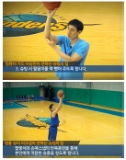

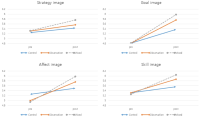
PURPOSE This study aims to analyze the effects of injury prevention video feedback on kinetic variables of the knee joint during the cutting maneuver. METHODS Twenty-eight healthy men participated and motion and force data were collected using infrared cameras, a force plate, and a Witty timing system. Paired t-tests were employed for data evaluation using the SPSS 26.0 program. RESULTS Results showed increased abduction and lateral rotation angles of the knee joint at the lower height of the center of mass (COM) (p<. 05). The lateral rotation of the knee joint decreased at initial ground contact (p<.05). Flexion angular velocity increased at initial ground contact after video feedback (p<.05) and decreased at the lower height of COM (p<.05). Abduction angular velocity decreased at the lower height of COM (p<.05), and internal rotation angular velocity was increased on the initial ground contact (p<.05). Maximum ground reaction force for anterior-posterior and medial-lateral directions increased after video feedback (p<.05). Flexion and internal rotation moments increased, and adduction moment also increased (p<.05). CONCLUSIONS In conclusion , video feedback effectively reduced knee load during the cutting maneuver, contributing to injury prevention for the knee joint.
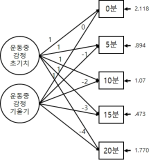
Recent research on exercise and affect has examined participants` affective changes during and after exercise with a longitudinal approach. With regard to this viewpoint, a theoretical model (Dual Mode model) has been presented to explain the different change of affect in an exercise setting and the model identified the impact of psychological factors on the affective changes. However, not only there is little empirical studies on the dual-mode model, but some relevant research has used an inappropriate statistical method (ANOVA), which cannot effectively explain the overall trends in affective change during and after exercise. Exiting research has a limitation to generalize the DM model examining only a certain gender such as active male or inactive female participants. Thus, the aim of present study was to investigate the effect of intrinsic motivation on affective change during and after exercise in participants who do not take part in regular exercise considering gender based difference. 51 inactive university students (M: 36, F: 15) responded a survey measuring intrinsic motivation for running activity and participated in moderate-intensity running exercise to examine affective change during exercise. Therefore, present study examined the influence of intrinsic motivation as a psychological variable on the trend of affective changes during and after exercise based on the dual mode model. Results from the latent curve model analysis revealed that there were decreasing trends of affect during exercise and the trends were individually different. Importantly, the decreasing trends were weaker in the participants with higher intrinsic motivation[FL=-.34, p=.000]. Additionally, participants` affective responses were positively changed after the exercise in general, but the changes were not influenced by intrinsic motivation. Therefore, the decreasing trend of affective change during exercise was weaker in the participants with higher intrinsic motivation, and the positive change in affect after exercise was not influenced by intrinsic motivation.

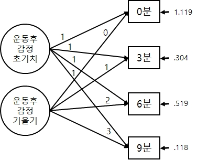
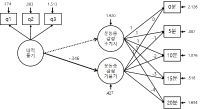

PURPOSE This study aimed to provide evidence for improving the working environment by exploring the phenomenon of presenteeism experienced by coaches. METHODS Ten coaches experiencing presenteeism were selected as participants of the study using the snowball sampling method, and in-depth interviews were conducted. The in-depth interviews were conducted for about 50 to 60 min using semi-structured questions organized through pre-expert meetings, and inductive content analysis was conducted. RESULTS First, the health problems that developed while coaching were categorized into two detailed areas (physical and psychological symptoms). Second, the causes of presenteeism were categorized into four general areas (policy and institutional problems, poor job environment, athlete problems, and human relations). Third, performance loss due to presenteeism was categorized into two general areas (coach-athlete relationship damage and poor training performance). Finally, coping with presenteeism was categorized into three detailed areas (private time spending, joining acquaintances, and changing training methods). CONCLUSIONS The result of this study confirmed that coaches are currently experiencing the phenomenon of presenteeism for various reasons, and the symptoms and coping method for this differ with each individual. However, the phenomenon of presenteeism experienced by coaches requires further future research since it is not easily observed and the coping method is not efficient.
Purpose Sperm quality and function are reduced by environmental factors (e.g., obesity), leading to increased infertility worldwide. Therefore, the purpose of this review paper was to investigate the effects of obesity and exercise training on sperm quality and function in animal and human models. Methods In order to determine the effects of obesity and exercise on sperm quality, motility, morphology, testosterone, oxidative stress, inflammation, we reviewed previous literatures with MEDLINE, PubMed, and Scopus databases. Results The most important factor to control the sperm motility is calcium ion, which is performed by the protein of CatSper (Cation Channel of Sperm). Obese men showed the decrease of number, concentration, motility, and volume in sperm, resulting in delayed or failed fertility. However, regular exercise training increased sperm-mediated factors including number, motility, and morphology, and festicular function-mediated factors including sperm concentration and serum testosterone. Conclusions While obesity exacerbates sperm quality and function in men, regular exercise training with moderate intensity increases sperm number and motility and reduces oxidative stress and inflammation, leading to the improvement of men’s fertility.
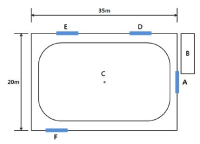
The purpose of this study was to examine the intensity of horseback riding as exercise (heart rate, oxygen intake, respiration exchange ratio, metabolism, energy expenditure) according to the tread of a horse such as walking, rising trotting, sitting trotting, and cantering. In this study, the subjects were 15 amateur horse riders. They participated in a 4-stage process(riding while the horse was walking, rising trotting, sitting trotting, and cantering) while wearing gas masks and heart rate belts for 5 minutes during each stage. Through this study, the average of heart rate, oxygen intake, respiration exchange ratio, metabolism, and energy expenditure in each stage of riding was attained and compared. The result of this study can be summarized as follows. First, the intensity of exercise by horse riding is significantly different depending on the tread of a horse. The intensity of exercise is increased as the speed of the horse's movements increased. Trotting and cantering show higher intensity than walking. Among the different treads of a horse, walking can be categorized as having an intermediate intensity of exercise, whereas trotting and cantering are categorized into a higher intensity. However, there are no significant differences in intensity between trotting and cantering. Second, there are no significant differences between male female participants in terms of intensity of exercise, but there are differences in the energy consumption per minute. The weight differences between male and female participants may be what cause this difference.

